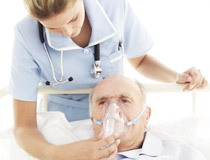Oxygen therapy

Oxygen therapy is the administration of oxygen via nasal cannula, face mask, endotracheal tube (tube inserted into the THROAT), or transtracheal catheter (small tube surgically placed through the outside of the throat into the TRACHEA). Oxygen therapy delivers oxygen at a percentage higher than that of normal air, which is 21 percent oxygen at sea level. Oxygen therapy can deliver oxygen from about 25 percent to 100 percent. This boosts the OXYGEN SATURATION of the BLOOD, which becomes necessary when the LUNGS cannot adequately diffuse oxygen into the blood or the HEART cannot circulate oxygenated blood at a level that meets the body’s needs.
Oxygen is highly flammable. Do not smoke, have an open flame, or use electrical appliances (including extension cords) in the vicinity of the oxygen supply.
Because 100 percent oxygen can be harmful to body tissues, doctors administer this level of oxygen therapy only to treat respiratory crisis. Supplemental oxygen therapy may be an element of treatment for cardiovascular conditions such as ISCHEMIC HEART DISEASE (IHD) and HEART FAILURE as well as pulmonary conditions such as CHRONIC OBSTRUCTIVE PULMONARY DISEASE (COPD), PNEUMONIA, severe ASTHMA, and ATELECTASIS.
In the hospital setting the oxygen supply is centralized, with access ports in patient care areas. Oxygen-delivery tubing plugs into the port, with an individualized flow regulator to adjust the percentage of oxygen. Oxygen tanks for home oxygen therapy contain compressed or frozen (liquid) oxygen, with flow regulators and often a device that releases oxygen only on inhalation. Home oxygen therapy may use an oxygen concentrator instead of supplemental oxygen. An oxygen concentrator extracts nitrogen from room air to increase the air’s concentration of oxygen. Oxygen concentrators can deliver oxygen only at low flow rates, however, making them useful only for people who require minimal oxygen supplementation. It is important to have adequate supplemental humidification as well during oxygen therapy, as the higher concentration of oxygen is drier than environmental air. Oxygen therapy may be short-term or long-term treatment, depending on the condition that causes its use. The person may also use oxygen therapy continuously, only during sleep, or only during physical activity depending on his or her underlying disease and respiratory needs.
| OXYGEN THERAPY | |
|---|---|
| Oxygen Therapy | Device Percentage of Oxygen |
| nasal cannula | 25 to 40 percent |
| face mask | 30 to 50 percent |
| nonrebreathing mask | 50 to 90 percent |
| transtracheal catheter | up to 100 percent |
| endotracheal tube | up to 100 percent |
| bag and mask resuscitator | up to 100 percent |
See also OXYGEN-CARBON DIOXIDE EXCHANGE; TRACHEOSTOMY.
Open discussion on the topic Oxygen therapy
Similar interests
- Nuovi Casino
- Casinos Not On Gamstop
- UK Casinos Not On Gamstop
- Casinos Not On Gamstop
- UK Casinos Not On Gamstop
- Casino Non Aams Italia
- Slot Sites Not On Gamstop
- Meilleur Casino En Ligne
- Non Gamstop Casino Sites UK
- Meilleur Casino En Ligne
- Casino En Ligne France
- Best Non Gamstop Casinos
- Casinos Not On Gamstop
- UK Casino Not On Gamstop
- Casinos Not Signed Up To Gamstop
- Best Slot Sites UK
- Non Gamstop Casino Sites UK
- Online Casinos Nederland
- Online Casinos Nederland
- Casinos Not On Gamstop
- Best New Uk Casinos Not On Gamstop
- Casino Non Aams
- Non Gamstop Casinos UK
- Migliori Siti Casino Non Aams
- Bitcoin Casinos